Auditing and Assurance Services
VerifiedAdded on 2020/03/04
|11
|2655
|53
AI Summary
This assignment delves into the critical aspects of auditing and assurance services. It emphasizes the importance of a thorough understanding of financial operations within an organization, particularly focusing on inventory valuation and evaluation methods. The assignment also stresses the significance of a well-structured audit plan, requiring auditors to meticulously analyze each item within the inventory for accurate assessment.
Contribute Materials
Your contribution can guide someone’s learning journey. Share your
documents today.
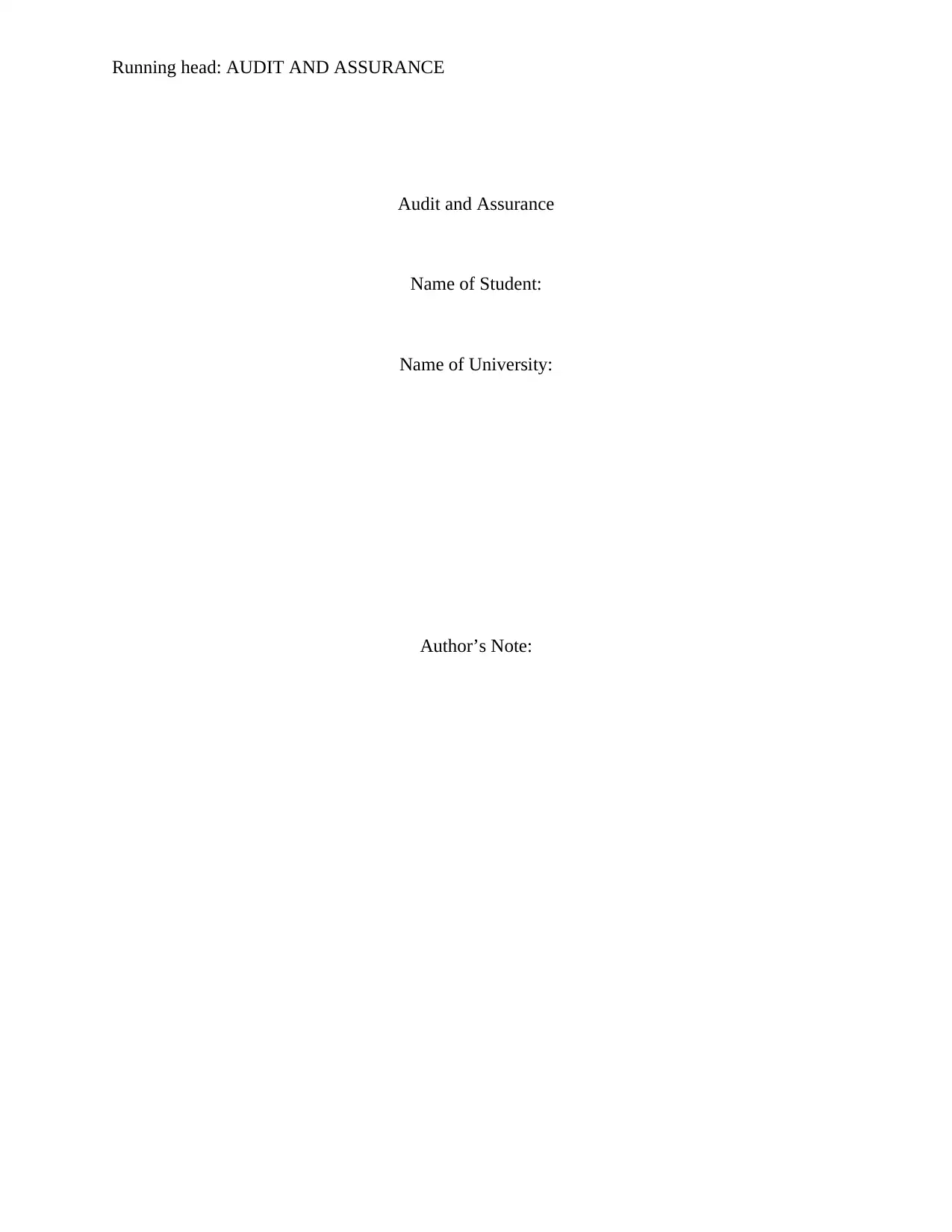
Running head: AUDIT AND ASSURANCE
Audit and Assurance
Name of Student:
Name of University:
Author’s Note:
Audit and Assurance
Name of Student:
Name of University:
Author’s Note:
Secure Best Marks with AI Grader
Need help grading? Try our AI Grader for instant feedback on your assignments.
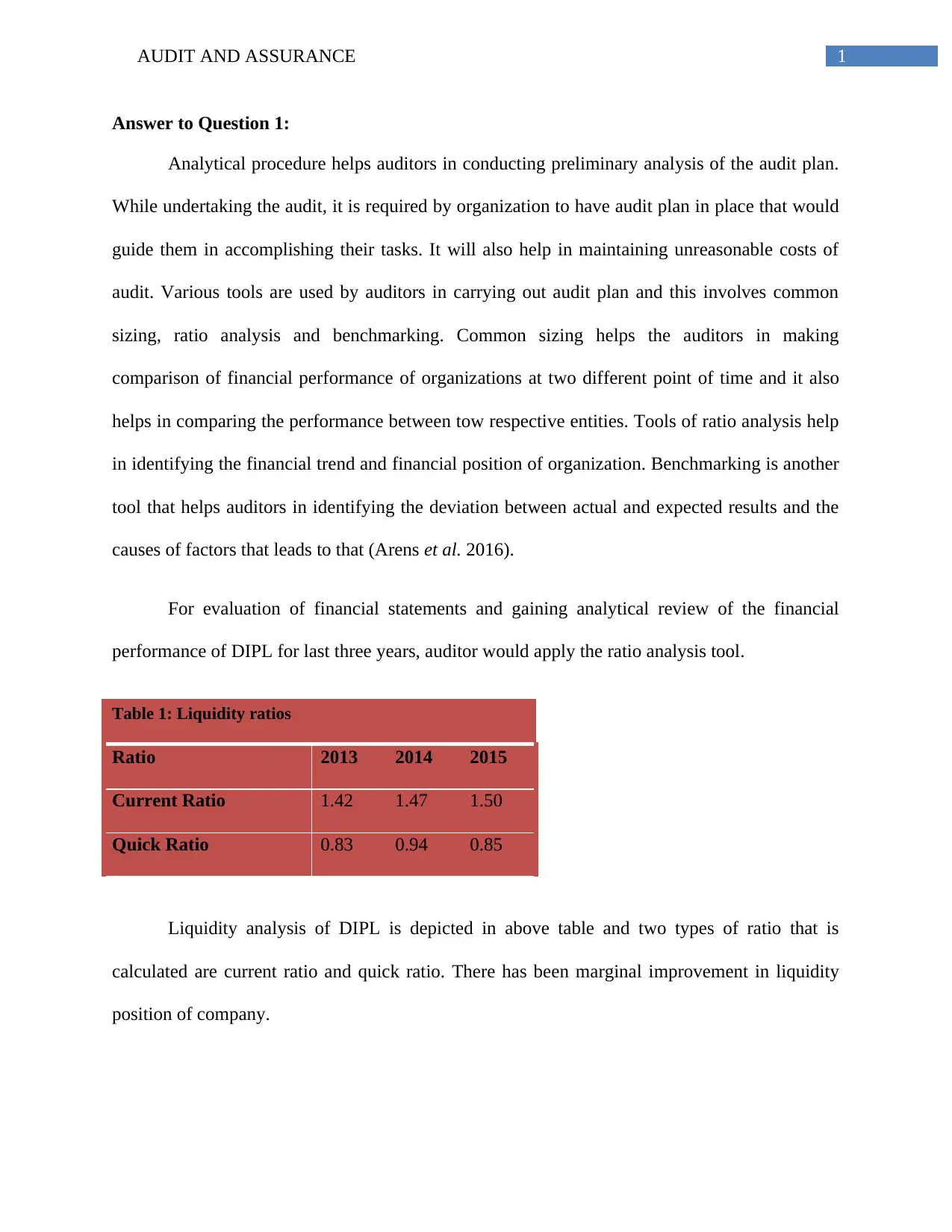
1AUDIT AND ASSURANCE
Answer to Question 1:
Analytical procedure helps auditors in conducting preliminary analysis of the audit plan.
While undertaking the audit, it is required by organization to have audit plan in place that would
guide them in accomplishing their tasks. It will also help in maintaining unreasonable costs of
audit. Various tools are used by auditors in carrying out audit plan and this involves common
sizing, ratio analysis and benchmarking. Common sizing helps the auditors in making
comparison of financial performance of organizations at two different point of time and it also
helps in comparing the performance between tow respective entities. Tools of ratio analysis help
in identifying the financial trend and financial position of organization. Benchmarking is another
tool that helps auditors in identifying the deviation between actual and expected results and the
causes of factors that leads to that (Arens et al. 2016).
For evaluation of financial statements and gaining analytical review of the financial
performance of DIPL for last three years, auditor would apply the ratio analysis tool.
Table 1: Liquidity ratios
Ratio 2013 2014 2015
Current Ratio 1.42 1.47 1.50
Quick Ratio 0.83 0.94 0.85
Liquidity analysis of DIPL is depicted in above table and two types of ratio that is
calculated are current ratio and quick ratio. There has been marginal improvement in liquidity
position of company.
Answer to Question 1:
Analytical procedure helps auditors in conducting preliminary analysis of the audit plan.
While undertaking the audit, it is required by organization to have audit plan in place that would
guide them in accomplishing their tasks. It will also help in maintaining unreasonable costs of
audit. Various tools are used by auditors in carrying out audit plan and this involves common
sizing, ratio analysis and benchmarking. Common sizing helps the auditors in making
comparison of financial performance of organizations at two different point of time and it also
helps in comparing the performance between tow respective entities. Tools of ratio analysis help
in identifying the financial trend and financial position of organization. Benchmarking is another
tool that helps auditors in identifying the deviation between actual and expected results and the
causes of factors that leads to that (Arens et al. 2016).
For evaluation of financial statements and gaining analytical review of the financial
performance of DIPL for last three years, auditor would apply the ratio analysis tool.
Table 1: Liquidity ratios
Ratio 2013 2014 2015
Current Ratio 1.42 1.47 1.50
Quick Ratio 0.83 0.94 0.85
Liquidity analysis of DIPL is depicted in above table and two types of ratio that is
calculated are current ratio and quick ratio. There has been marginal improvement in liquidity
position of company.
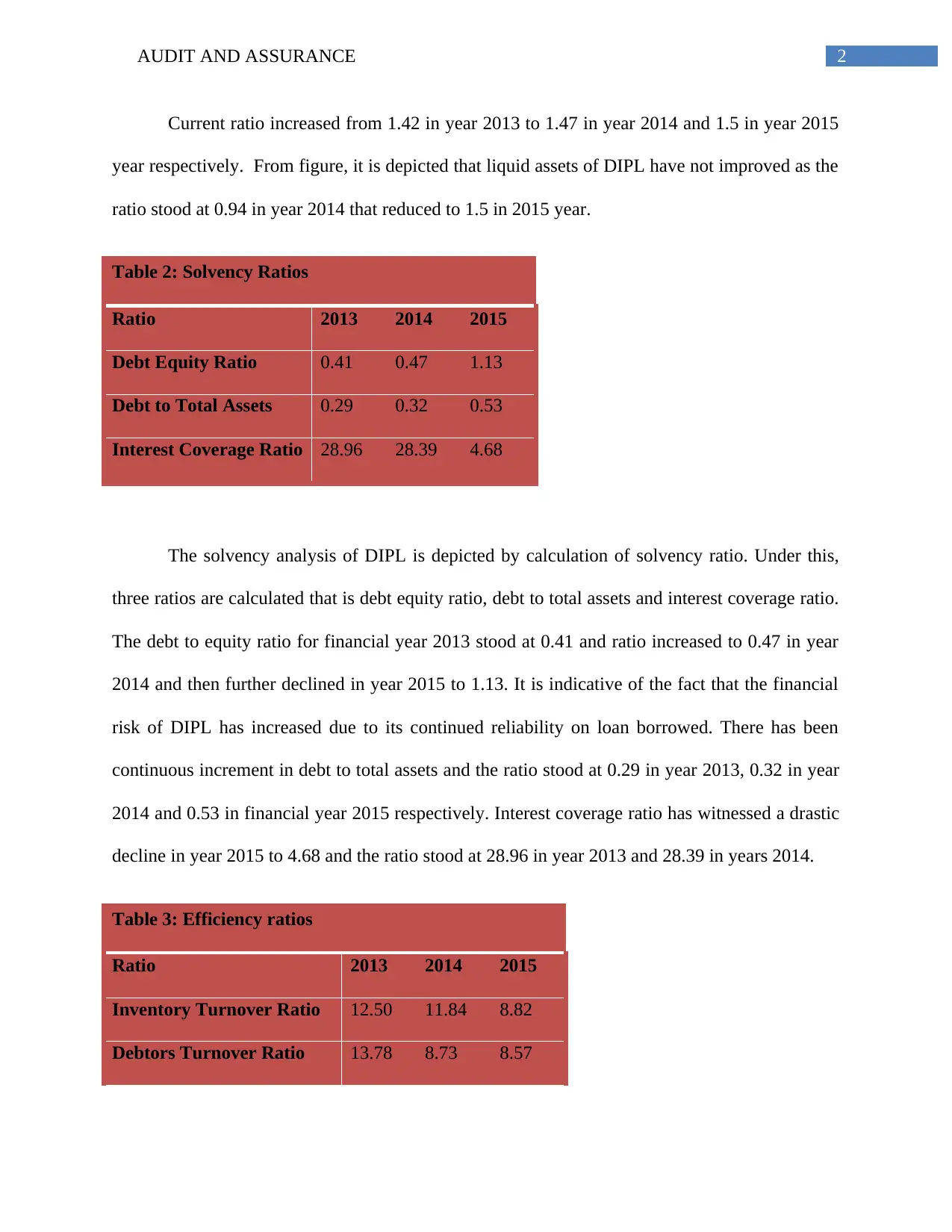
2AUDIT AND ASSURANCE
Current ratio increased from 1.42 in year 2013 to 1.47 in year 2014 and 1.5 in year 2015
year respectively. From figure, it is depicted that liquid assets of DIPL have not improved as the
ratio stood at 0.94 in year 2014 that reduced to 1.5 in 2015 year.
Table 2: Solvency Ratios
Ratio 2013 2014 2015
Debt Equity Ratio 0.41 0.47 1.13
Debt to Total Assets 0.29 0.32 0.53
Interest Coverage Ratio 28.96 28.39 4.68
The solvency analysis of DIPL is depicted by calculation of solvency ratio. Under this,
three ratios are calculated that is debt equity ratio, debt to total assets and interest coverage ratio.
The debt to equity ratio for financial year 2013 stood at 0.41 and ratio increased to 0.47 in year
2014 and then further declined in year 2015 to 1.13. It is indicative of the fact that the financial
risk of DIPL has increased due to its continued reliability on loan borrowed. There has been
continuous increment in debt to total assets and the ratio stood at 0.29 in year 2013, 0.32 in year
2014 and 0.53 in financial year 2015 respectively. Interest coverage ratio has witnessed a drastic
decline in year 2015 to 4.68 and the ratio stood at 28.96 in year 2013 and 28.39 in years 2014.
Table 3: Efficiency ratios
Ratio 2013 2014 2015
Inventory Turnover Ratio 12.50 11.84 8.82
Debtors Turnover Ratio 13.78 8.73 8.57
Current ratio increased from 1.42 in year 2013 to 1.47 in year 2014 and 1.5 in year 2015
year respectively. From figure, it is depicted that liquid assets of DIPL have not improved as the
ratio stood at 0.94 in year 2014 that reduced to 1.5 in 2015 year.
Table 2: Solvency Ratios
Ratio 2013 2014 2015
Debt Equity Ratio 0.41 0.47 1.13
Debt to Total Assets 0.29 0.32 0.53
Interest Coverage Ratio 28.96 28.39 4.68
The solvency analysis of DIPL is depicted by calculation of solvency ratio. Under this,
three ratios are calculated that is debt equity ratio, debt to total assets and interest coverage ratio.
The debt to equity ratio for financial year 2013 stood at 0.41 and ratio increased to 0.47 in year
2014 and then further declined in year 2015 to 1.13. It is indicative of the fact that the financial
risk of DIPL has increased due to its continued reliability on loan borrowed. There has been
continuous increment in debt to total assets and the ratio stood at 0.29 in year 2013, 0.32 in year
2014 and 0.53 in financial year 2015 respectively. Interest coverage ratio has witnessed a drastic
decline in year 2015 to 4.68 and the ratio stood at 28.96 in year 2013 and 28.39 in years 2014.
Table 3: Efficiency ratios
Ratio 2013 2014 2015
Inventory Turnover Ratio 12.50 11.84 8.82
Debtors Turnover Ratio 13.78 8.73 8.57
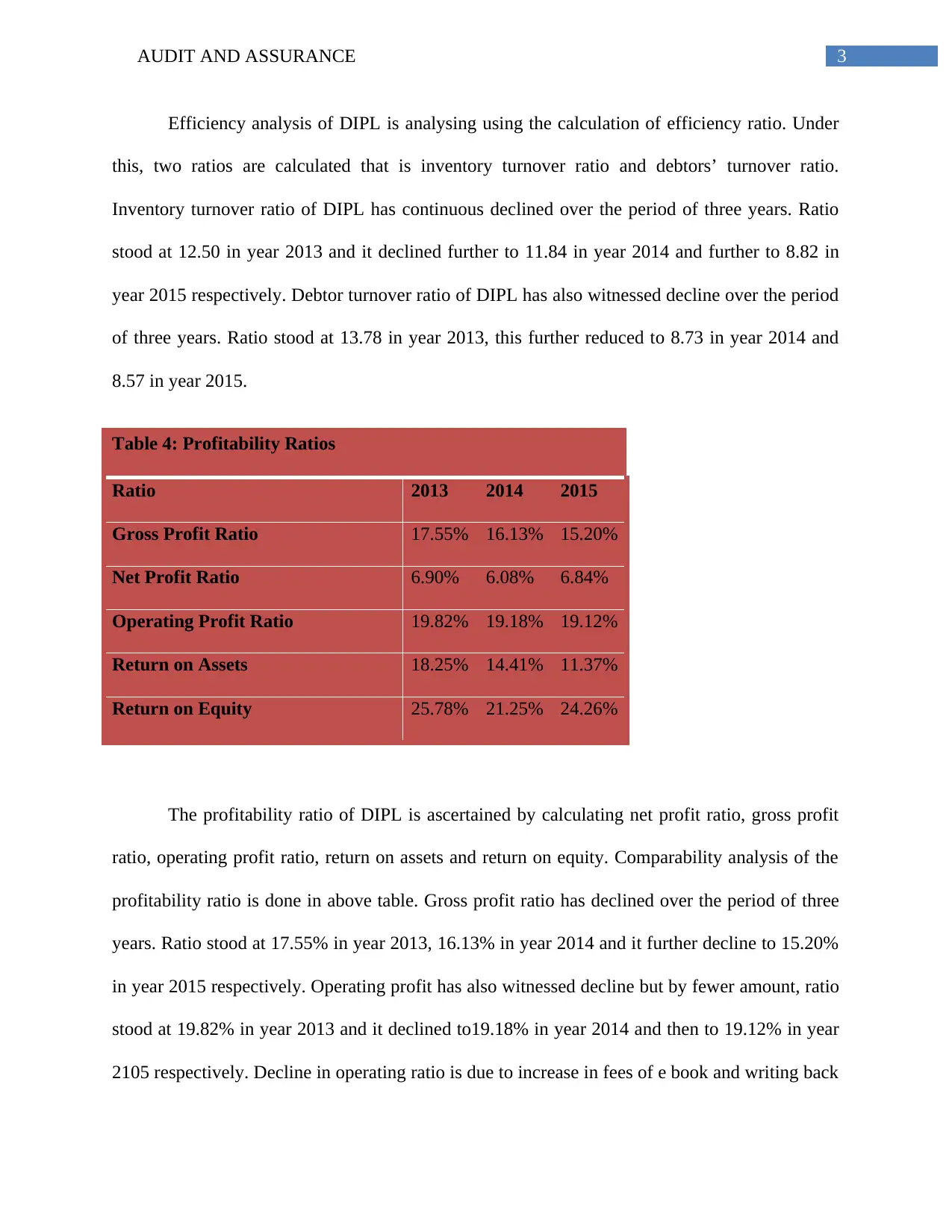
3AUDIT AND ASSURANCE
Efficiency analysis of DIPL is analysing using the calculation of efficiency ratio. Under
this, two ratios are calculated that is inventory turnover ratio and debtors’ turnover ratio.
Inventory turnover ratio of DIPL has continuous declined over the period of three years. Ratio
stood at 12.50 in year 2013 and it declined further to 11.84 in year 2014 and further to 8.82 in
year 2015 respectively. Debtor turnover ratio of DIPL has also witnessed decline over the period
of three years. Ratio stood at 13.78 in year 2013, this further reduced to 8.73 in year 2014 and
8.57 in year 2015.
Table 4: Profitability Ratios
Ratio 2013 2014 2015
Gross Profit Ratio 17.55% 16.13% 15.20%
Net Profit Ratio 6.90% 6.08% 6.84%
Operating Profit Ratio 19.82% 19.18% 19.12%
Return on Assets 18.25% 14.41% 11.37%
Return on Equity 25.78% 21.25% 24.26%
The profitability ratio of DIPL is ascertained by calculating net profit ratio, gross profit
ratio, operating profit ratio, return on assets and return on equity. Comparability analysis of the
profitability ratio is done in above table. Gross profit ratio has declined over the period of three
years. Ratio stood at 17.55% in year 2013, 16.13% in year 2014 and it further decline to 15.20%
in year 2015 respectively. Operating profit has also witnessed decline but by fewer amount, ratio
stood at 19.82% in year 2013 and it declined to19.18% in year 2014 and then to 19.12% in year
2105 respectively. Decline in operating ratio is due to increase in fees of e book and writing back
Efficiency analysis of DIPL is analysing using the calculation of efficiency ratio. Under
this, two ratios are calculated that is inventory turnover ratio and debtors’ turnover ratio.
Inventory turnover ratio of DIPL has continuous declined over the period of three years. Ratio
stood at 12.50 in year 2013 and it declined further to 11.84 in year 2014 and further to 8.82 in
year 2015 respectively. Debtor turnover ratio of DIPL has also witnessed decline over the period
of three years. Ratio stood at 13.78 in year 2013, this further reduced to 8.73 in year 2014 and
8.57 in year 2015.
Table 4: Profitability Ratios
Ratio 2013 2014 2015
Gross Profit Ratio 17.55% 16.13% 15.20%
Net Profit Ratio 6.90% 6.08% 6.84%
Operating Profit Ratio 19.82% 19.18% 19.12%
Return on Assets 18.25% 14.41% 11.37%
Return on Equity 25.78% 21.25% 24.26%
The profitability ratio of DIPL is ascertained by calculating net profit ratio, gross profit
ratio, operating profit ratio, return on assets and return on equity. Comparability analysis of the
profitability ratio is done in above table. Gross profit ratio has declined over the period of three
years. Ratio stood at 17.55% in year 2013, 16.13% in year 2014 and it further decline to 15.20%
in year 2015 respectively. Operating profit has also witnessed decline but by fewer amount, ratio
stood at 19.82% in year 2013 and it declined to19.18% in year 2014 and then to 19.12% in year
2105 respectively. Decline in operating ratio is due to increase in fees of e book and writing back
Secure Best Marks with AI Grader
Need help grading? Try our AI Grader for instant feedback on your assignments.
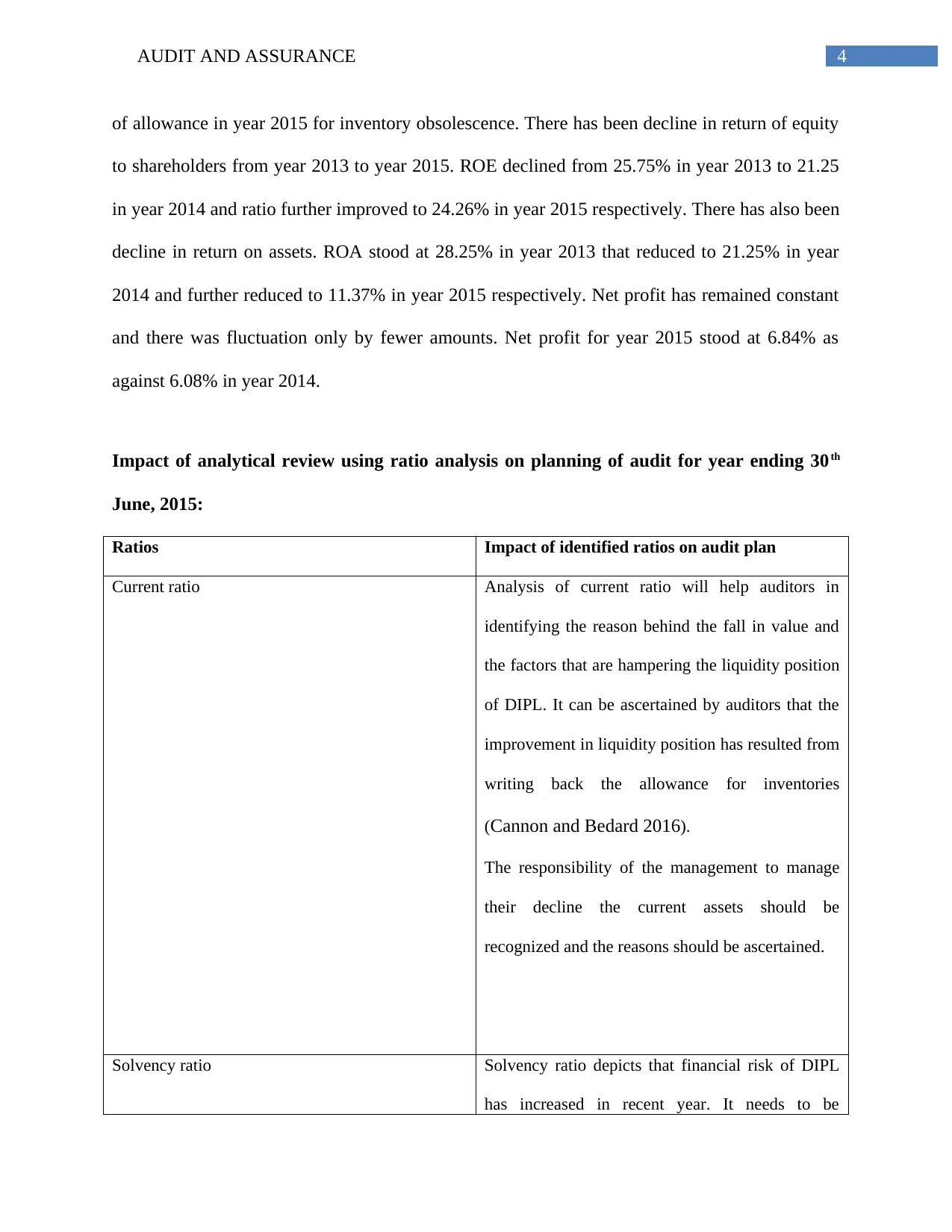
4AUDIT AND ASSURANCE
of allowance in year 2015 for inventory obsolescence. There has been decline in return of equity
to shareholders from year 2013 to year 2015. ROE declined from 25.75% in year 2013 to 21.25
in year 2014 and ratio further improved to 24.26% in year 2015 respectively. There has also been
decline in return on assets. ROA stood at 28.25% in year 2013 that reduced to 21.25% in year
2014 and further reduced to 11.37% in year 2015 respectively. Net profit has remained constant
and there was fluctuation only by fewer amounts. Net profit for year 2015 stood at 6.84% as
against 6.08% in year 2014.
Impact of analytical review using ratio analysis on planning of audit for year ending 30th
June, 2015:
Ratios Impact of identified ratios on audit plan
Current ratio Analysis of current ratio will help auditors in
identifying the reason behind the fall in value and
the factors that are hampering the liquidity position
of DIPL. It can be ascertained by auditors that the
improvement in liquidity position has resulted from
writing back the allowance for inventories
(Cannon and Bedard 2016).
The responsibility of the management to manage
their decline the current assets should be
recognized and the reasons should be ascertained.
Solvency ratio Solvency ratio depicts that financial risk of DIPL
has increased in recent year. It needs to be
of allowance in year 2015 for inventory obsolescence. There has been decline in return of equity
to shareholders from year 2013 to year 2015. ROE declined from 25.75% in year 2013 to 21.25
in year 2014 and ratio further improved to 24.26% in year 2015 respectively. There has also been
decline in return on assets. ROA stood at 28.25% in year 2013 that reduced to 21.25% in year
2014 and further reduced to 11.37% in year 2015 respectively. Net profit has remained constant
and there was fluctuation only by fewer amounts. Net profit for year 2015 stood at 6.84% as
against 6.08% in year 2014.
Impact of analytical review using ratio analysis on planning of audit for year ending 30th
June, 2015:
Ratios Impact of identified ratios on audit plan
Current ratio Analysis of current ratio will help auditors in
identifying the reason behind the fall in value and
the factors that are hampering the liquidity position
of DIPL. It can be ascertained by auditors that the
improvement in liquidity position has resulted from
writing back the allowance for inventories
(Cannon and Bedard 2016).
The responsibility of the management to manage
their decline the current assets should be
recognized and the reasons should be ascertained.
Solvency ratio Solvency ratio depicts that financial risk of DIPL
has increased in recent year. It needs to be
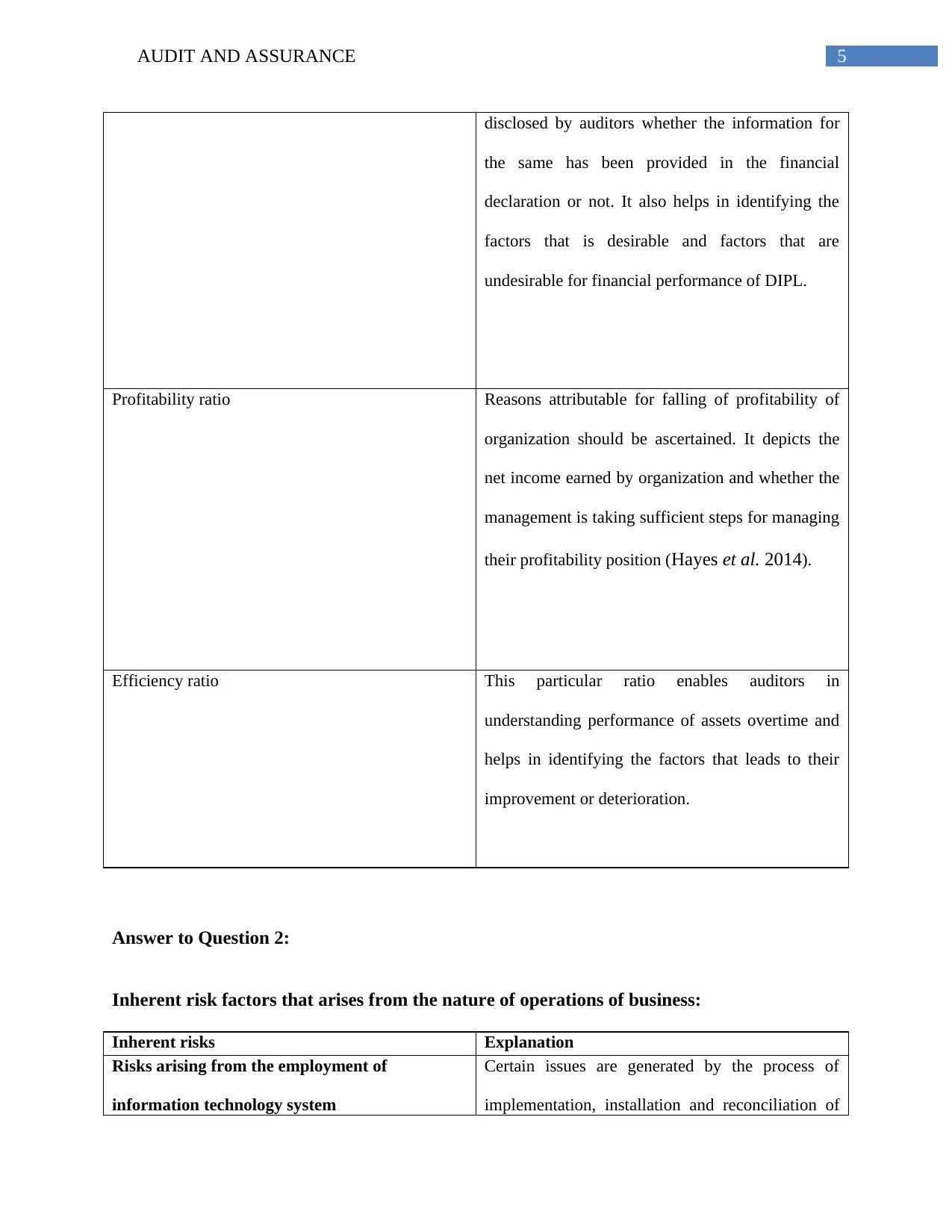
5AUDIT AND ASSURANCE
disclosed by auditors whether the information for
the same has been provided in the financial
declaration or not. It also helps in identifying the
factors that is desirable and factors that are
undesirable for financial performance of DIPL.
Profitability ratio Reasons attributable for falling of profitability of
organization should be ascertained. It depicts the
net income earned by organization and whether the
management is taking sufficient steps for managing
their profitability position (Hayes et al. 2014).
Efficiency ratio This particular ratio enables auditors in
understanding performance of assets overtime and
helps in identifying the factors that leads to their
improvement or deterioration.
Answer to Question 2:
Inherent risk factors that arises from the nature of operations of business:
Inherent risks Explanation
Risks arising from the employment of
information technology system
Certain issues are generated by the process of
implementation, installation and reconciliation of
disclosed by auditors whether the information for
the same has been provided in the financial
declaration or not. It also helps in identifying the
factors that is desirable and factors that are
undesirable for financial performance of DIPL.
Profitability ratio Reasons attributable for falling of profitability of
organization should be ascertained. It depicts the
net income earned by organization and whether the
management is taking sufficient steps for managing
their profitability position (Hayes et al. 2014).
Efficiency ratio This particular ratio enables auditors in
understanding performance of assets overtime and
helps in identifying the factors that leads to their
improvement or deterioration.
Answer to Question 2:
Inherent risk factors that arises from the nature of operations of business:
Inherent risks Explanation
Risks arising from the employment of
information technology system
Certain issues are generated by the process of
implementation, installation and reconciliation of
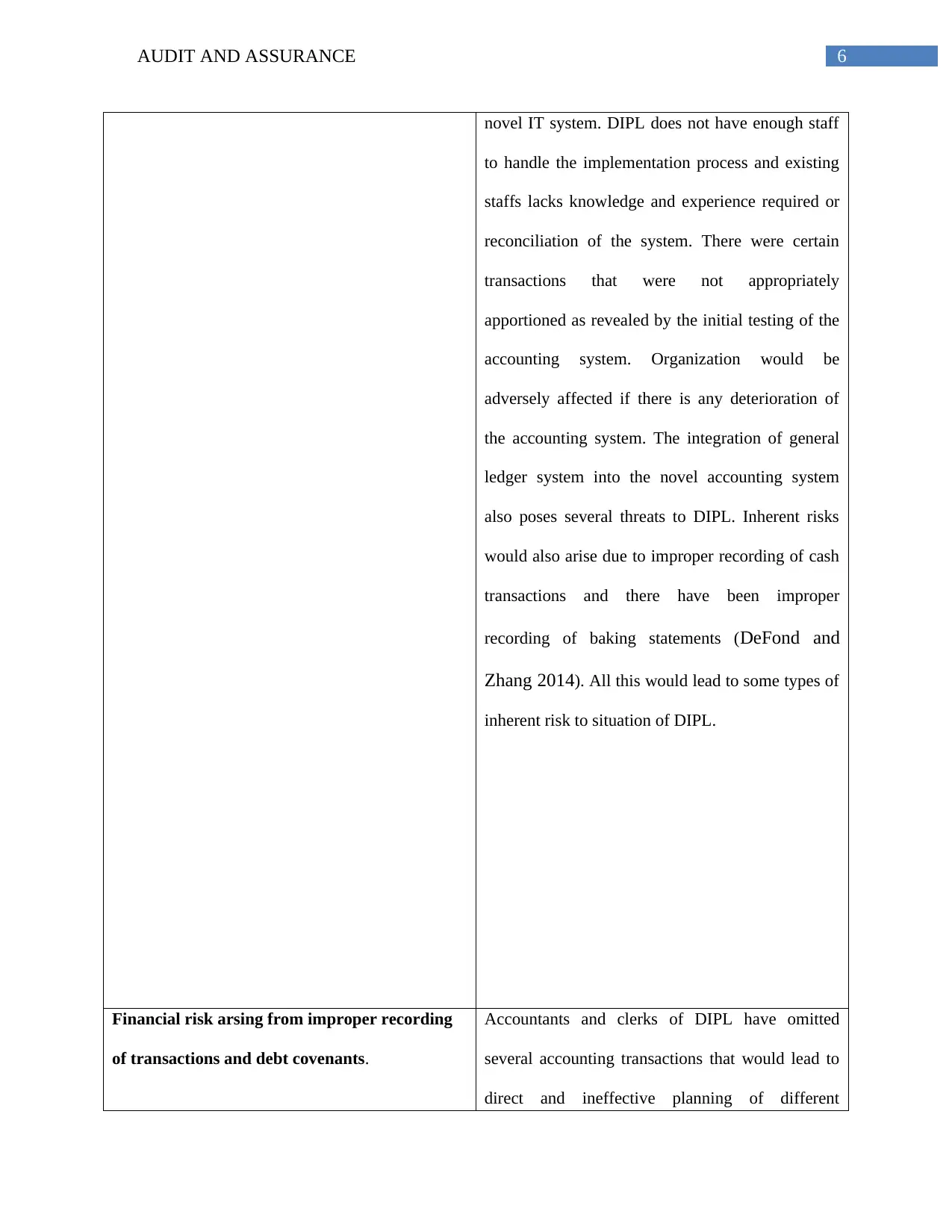
6AUDIT AND ASSURANCE
novel IT system. DIPL does not have enough staff
to handle the implementation process and existing
staffs lacks knowledge and experience required or
reconciliation of the system. There were certain
transactions that were not appropriately
apportioned as revealed by the initial testing of the
accounting system. Organization would be
adversely affected if there is any deterioration of
the accounting system. The integration of general
ledger system into the novel accounting system
also poses several threats to DIPL. Inherent risks
would also arise due to improper recording of cash
transactions and there have been improper
recording of baking statements (DeFond and
Zhang 2014). All this would lead to some types of
inherent risk to situation of DIPL.
Financial risk arsing from improper recording
of transactions and debt covenants.
Accountants and clerks of DIPL have omitted
several accounting transactions that would lead to
direct and ineffective planning of different
novel IT system. DIPL does not have enough staff
to handle the implementation process and existing
staffs lacks knowledge and experience required or
reconciliation of the system. There were certain
transactions that were not appropriately
apportioned as revealed by the initial testing of the
accounting system. Organization would be
adversely affected if there is any deterioration of
the accounting system. The integration of general
ledger system into the novel accounting system
also poses several threats to DIPL. Inherent risks
would also arise due to improper recording of cash
transactions and there have been improper
recording of baking statements (DeFond and
Zhang 2014). All this would lead to some types of
inherent risk to situation of DIPL.
Financial risk arsing from improper recording
of transactions and debt covenants.
Accountants and clerks of DIPL have omitted
several accounting transactions that would lead to
direct and ineffective planning of different
Paraphrase This Document
Need a fresh take? Get an instant paraphrase of this document with our AI Paraphraser
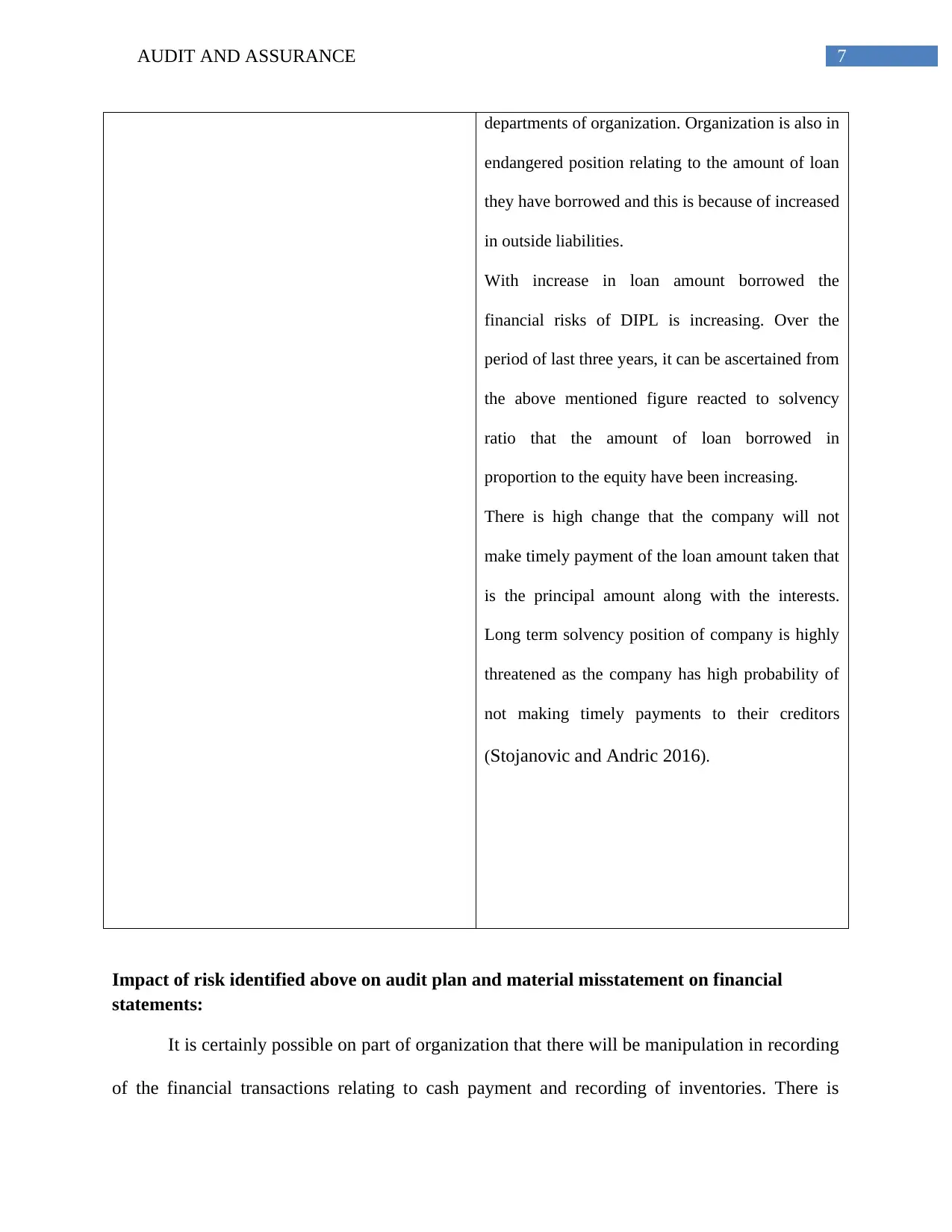
7AUDIT AND ASSURANCE
departments of organization. Organization is also in
endangered position relating to the amount of loan
they have borrowed and this is because of increased
in outside liabilities.
With increase in loan amount borrowed the
financial risks of DIPL is increasing. Over the
period of last three years, it can be ascertained from
the above mentioned figure reacted to solvency
ratio that the amount of loan borrowed in
proportion to the equity have been increasing.
There is high change that the company will not
make timely payment of the loan amount taken that
is the principal amount along with the interests.
Long term solvency position of company is highly
threatened as the company has high probability of
not making timely payments to their creditors
(Stojanovic and Andric 2016).
Impact of risk identified above on audit plan and material misstatement on financial
statements:
It is certainly possible on part of organization that there will be manipulation in recording
of the financial transactions relating to cash payment and recording of inventories. There is
departments of organization. Organization is also in
endangered position relating to the amount of loan
they have borrowed and this is because of increased
in outside liabilities.
With increase in loan amount borrowed the
financial risks of DIPL is increasing. Over the
period of last three years, it can be ascertained from
the above mentioned figure reacted to solvency
ratio that the amount of loan borrowed in
proportion to the equity have been increasing.
There is high change that the company will not
make timely payment of the loan amount taken that
is the principal amount along with the interests.
Long term solvency position of company is highly
threatened as the company has high probability of
not making timely payments to their creditors
(Stojanovic and Andric 2016).
Impact of risk identified above on audit plan and material misstatement on financial
statements:
It is certainly possible on part of organization that there will be manipulation in recording
of the financial transactions relating to cash payment and recording of inventories. There is
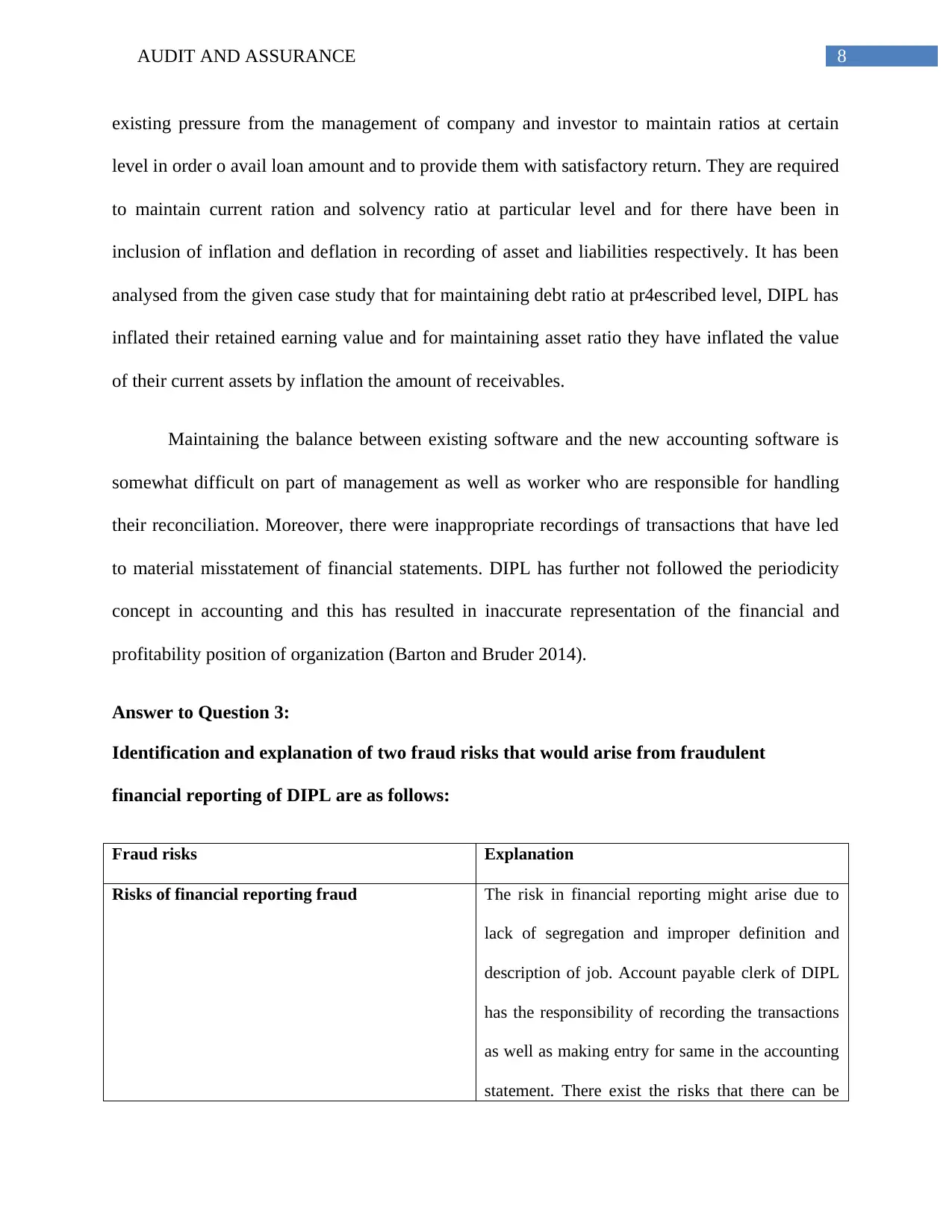
8AUDIT AND ASSURANCE
existing pressure from the management of company and investor to maintain ratios at certain
level in order o avail loan amount and to provide them with satisfactory return. They are required
to maintain current ration and solvency ratio at particular level and for there have been in
inclusion of inflation and deflation in recording of asset and liabilities respectively. It has been
analysed from the given case study that for maintaining debt ratio at pr4escribed level, DIPL has
inflated their retained earning value and for maintaining asset ratio they have inflated the value
of their current assets by inflation the amount of receivables.
Maintaining the balance between existing software and the new accounting software is
somewhat difficult on part of management as well as worker who are responsible for handling
their reconciliation. Moreover, there were inappropriate recordings of transactions that have led
to material misstatement of financial statements. DIPL has further not followed the periodicity
concept in accounting and this has resulted in inaccurate representation of the financial and
profitability position of organization (Barton and Bruder 2014).
Answer to Question 3:
Identification and explanation of two fraud risks that would arise from fraudulent
financial reporting of DIPL are as follows:
Fraud risks Explanation
Risks of financial reporting fraud The risk in financial reporting might arise due to
lack of segregation and improper definition and
description of job. Account payable clerk of DIPL
has the responsibility of recording the transactions
as well as making entry for same in the accounting
statement. There exist the risks that there can be
existing pressure from the management of company and investor to maintain ratios at certain
level in order o avail loan amount and to provide them with satisfactory return. They are required
to maintain current ration and solvency ratio at particular level and for there have been in
inclusion of inflation and deflation in recording of asset and liabilities respectively. It has been
analysed from the given case study that for maintaining debt ratio at pr4escribed level, DIPL has
inflated their retained earning value and for maintaining asset ratio they have inflated the value
of their current assets by inflation the amount of receivables.
Maintaining the balance between existing software and the new accounting software is
somewhat difficult on part of management as well as worker who are responsible for handling
their reconciliation. Moreover, there were inappropriate recordings of transactions that have led
to material misstatement of financial statements. DIPL has further not followed the periodicity
concept in accounting and this has resulted in inaccurate representation of the financial and
profitability position of organization (Barton and Bruder 2014).
Answer to Question 3:
Identification and explanation of two fraud risks that would arise from fraudulent
financial reporting of DIPL are as follows:
Fraud risks Explanation
Risks of financial reporting fraud The risk in financial reporting might arise due to
lack of segregation and improper definition and
description of job. Account payable clerk of DIPL
has the responsibility of recording the transactions
as well as making entry for same in the accounting
statement. There exist the risks that there can be
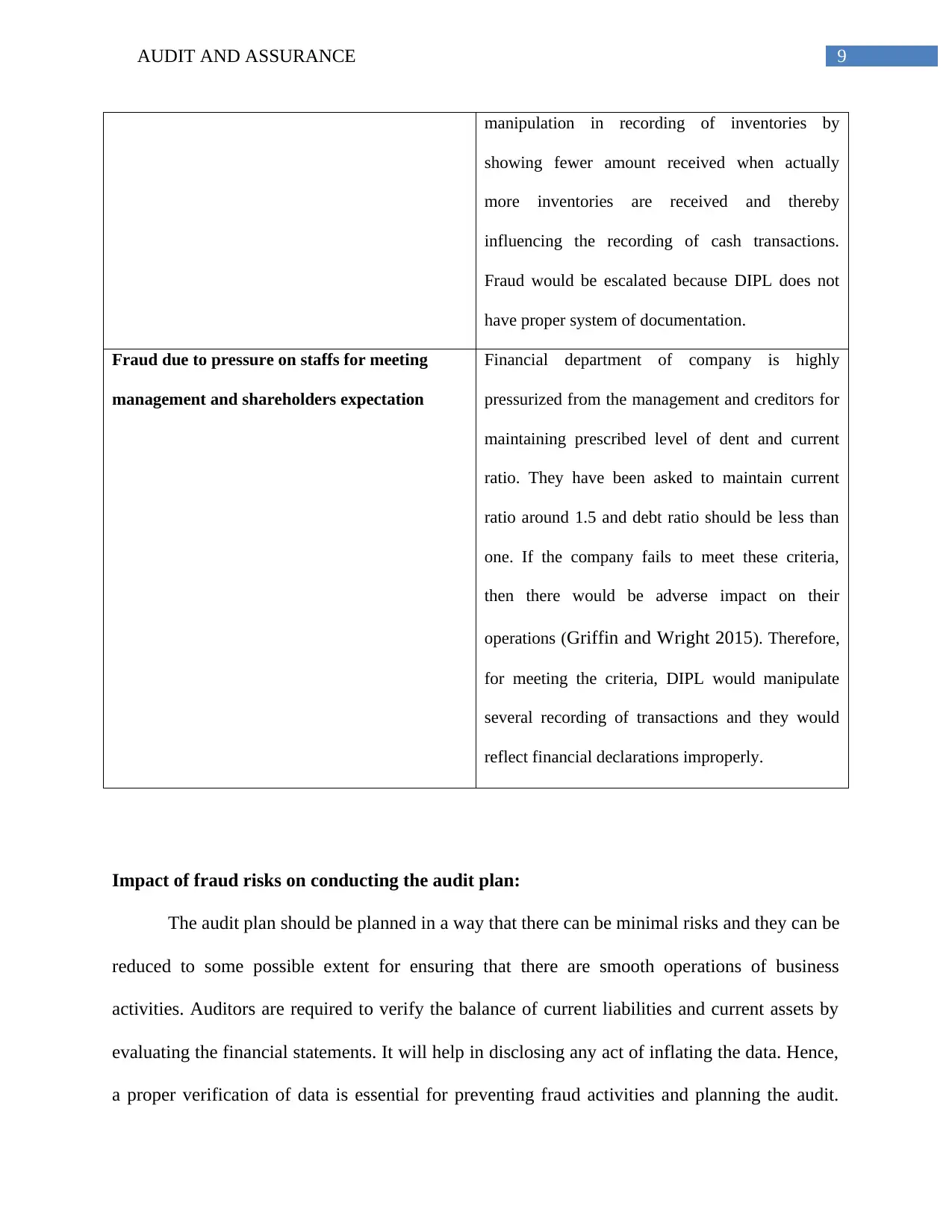
9AUDIT AND ASSURANCE
manipulation in recording of inventories by
showing fewer amount received when actually
more inventories are received and thereby
influencing the recording of cash transactions.
Fraud would be escalated because DIPL does not
have proper system of documentation.
Fraud due to pressure on staffs for meeting
management and shareholders expectation
Financial department of company is highly
pressurized from the management and creditors for
maintaining prescribed level of dent and current
ratio. They have been asked to maintain current
ratio around 1.5 and debt ratio should be less than
one. If the company fails to meet these criteria,
then there would be adverse impact on their
operations (Griffin and Wright 2015). Therefore,
for meeting the criteria, DIPL would manipulate
several recording of transactions and they would
reflect financial declarations improperly.
Impact of fraud risks on conducting the audit plan:
The audit plan should be planned in a way that there can be minimal risks and they can be
reduced to some possible extent for ensuring that there are smooth operations of business
activities. Auditors are required to verify the balance of current liabilities and current assets by
evaluating the financial statements. It will help in disclosing any act of inflating the data. Hence,
a proper verification of data is essential for preventing fraud activities and planning the audit.
manipulation in recording of inventories by
showing fewer amount received when actually
more inventories are received and thereby
influencing the recording of cash transactions.
Fraud would be escalated because DIPL does not
have proper system of documentation.
Fraud due to pressure on staffs for meeting
management and shareholders expectation
Financial department of company is highly
pressurized from the management and creditors for
maintaining prescribed level of dent and current
ratio. They have been asked to maintain current
ratio around 1.5 and debt ratio should be less than
one. If the company fails to meet these criteria,
then there would be adverse impact on their
operations (Griffin and Wright 2015). Therefore,
for meeting the criteria, DIPL would manipulate
several recording of transactions and they would
reflect financial declarations improperly.
Impact of fraud risks on conducting the audit plan:
The audit plan should be planned in a way that there can be minimal risks and they can be
reduced to some possible extent for ensuring that there are smooth operations of business
activities. Auditors are required to verify the balance of current liabilities and current assets by
evaluating the financial statements. It will help in disclosing any act of inflating the data. Hence,
a proper verification of data is essential for preventing fraud activities and planning the audit.
Secure Best Marks with AI Grader
Need help grading? Try our AI Grader for instant feedback on your assignments.
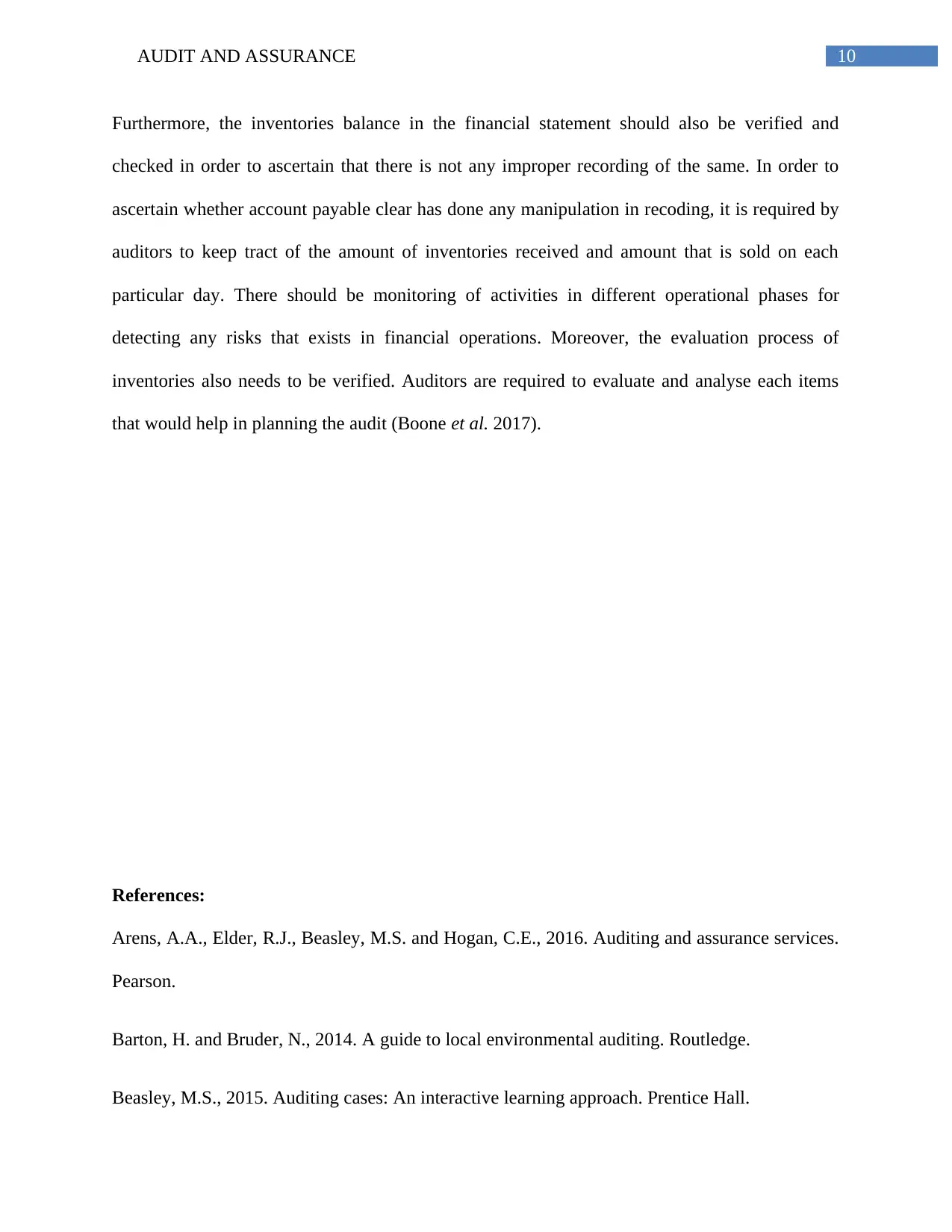
10AUDIT AND ASSURANCE
Furthermore, the inventories balance in the financial statement should also be verified and
checked in order to ascertain that there is not any improper recording of the same. In order to
ascertain whether account payable clear has done any manipulation in recoding, it is required by
auditors to keep tract of the amount of inventories received and amount that is sold on each
particular day. There should be monitoring of activities in different operational phases for
detecting any risks that exists in financial operations. Moreover, the evaluation process of
inventories also needs to be verified. Auditors are required to evaluate and analyse each items
that would help in planning the audit (Boone et al. 2017).
References:
Arens, A.A., Elder, R.J., Beasley, M.S. and Hogan, C.E., 2016. Auditing and assurance services.
Pearson.
Barton, H. and Bruder, N., 2014. A guide to local environmental auditing. Routledge.
Beasley, M.S., 2015. Auditing cases: An interactive learning approach. Prentice Hall.
Furthermore, the inventories balance in the financial statement should also be verified and
checked in order to ascertain that there is not any improper recording of the same. In order to
ascertain whether account payable clear has done any manipulation in recoding, it is required by
auditors to keep tract of the amount of inventories received and amount that is sold on each
particular day. There should be monitoring of activities in different operational phases for
detecting any risks that exists in financial operations. Moreover, the evaluation process of
inventories also needs to be verified. Auditors are required to evaluate and analyse each items
that would help in planning the audit (Boone et al. 2017).
References:
Arens, A.A., Elder, R.J., Beasley, M.S. and Hogan, C.E., 2016. Auditing and assurance services.
Pearson.
Barton, H. and Bruder, N., 2014. A guide to local environmental auditing. Routledge.
Beasley, M.S., 2015. Auditing cases: An interactive learning approach. Prentice Hall.
1 out of 11
Related Documents
Your All-in-One AI-Powered Toolkit for Academic Success.
+13062052269
info@desklib.com
Available 24*7 on WhatsApp / Email
![[object Object]](/_next/static/media/star-bottom.7253800d.svg)
Unlock your academic potential
© 2024 | Zucol Services PVT LTD | All rights reserved.





